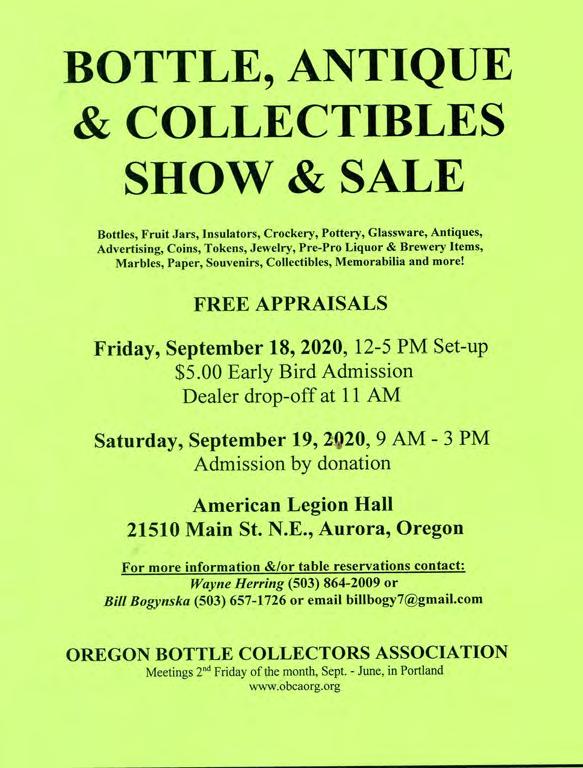
5 minute read
Nevada's Desert Shrine to the Lowly Beer Bottle by Jack Sullivan
Nevada’s Desert Shrine to the Lowly Beer Bottle
By Jack Sullivan (Special to Bottles and Extras)
Fig. 2: Postcard view of bottle house
Consider the beer bottle (Fig. 1): When drained of its contents it is known popularly as a “dead soldier.” When stripped of its label it is as featureless as a fencepost, an artifact disdained by collectors whose hearts otherwise beat faster at the sight of an elaborately embossed glass container. Yet in a Nevada desert adjacent to Death Valley stands a shrine to that lowly object — a house built of more than 50,000 beer bottles (Fig. 2).

The dwelling was the handiwork of a saloonkeeper named Tom Kelly in Rhyolite, Nevada, a gold rush boomtown of the early 1900s. Kelly’s choice of building materials was driven by a lack of good local timber. He chose bottles, he said because “it's very difficult to build a house with lumber from a Joshua tree." Beer bottles were particularly common in Rhyolite, a town that boasted dozens of saloons. Kelly collected and used an estimated 51,000 bottles to construct his structure of glass. The saloon

Fig. 1: Beer bottle
Fig. 3: Close up view of wall



Fig. 5: Ad with cowboy
Fig. 6: Pavilion to glass factory


keeper laid the bottles on their sides, with the bottoms facing out, and mortared them together with adobe mud (Fig 3).
For his building materials, Kelly could thank Adolphus Busch, the founder and moving force behind the Anheuser Busch brewery in St. Louis, Missouri. Perhaps wiser than other brewers of his time, Adolphus (Fig. 4) understood that the small and often isolated mining camps and towns of the Old West represented the wealth and future growth of the United States. He literally flooded the mountains, deserts and plains with his golden liquid. Busch ads emphasized bringing the bottled brews by mule train over the hills and through the valleys, led by cowboys in ten gallon hats and riding white horses (Fig. 5). Actually, by the 1900s railroads reached many Western locations, including Rhyolite, and brought cases of beer.
The St. Louis “Beer Baron” was fixated on bottles. In order to keep up with his brewery production Busch had an ever-increasing need for glass containers and once was forced to import them from Germany. To be assured of a supply he formed a series of companies to manufacture bottles. In 1886 Busch bought a glass works in Belleville, Illinois, changing its name to his own. Subsequently he incorporated the Adolphus Busch Glass Manufacturing Co. in St. Louis, buying the Belgian Pavilion at the New Orleans Louisiana Purchase Exposition and moving it to Missouri to be fitted out as his factory (Fig. 6). As a result, the principal base marks found on the bottles Kelly used in his walls are the “AB” of Anheuser Busch (Fig. 7).
Almost as numerous in the house are beers with a “R&CO” mark and a number (Fig. 8). Those were from the Reed & Company’s Massillon, Ohio, Glass Works, founded in 1881. That company specialized in supplying beer bottles to western breweries and Adolphus was a major customer. All the bottles used in Kelly’s house would now be well more than 100 years old. Estimates differ widely on how long it took the saloonkeeper to build the three room, L-shaped dwelling. Some accounts say five months, others more than a year. He is believed to have spent about $2,500 on the building with most the money going for wood trim and fixtures. Whatever Kelly’s original intention,
Fig. 7: AB bottles
by the time the house was finished he had a new idea. Whether it was his advancing age, the foresight to see a dim future for Rhyolite, or another reason, upon completion Kelly decided to capitalize on the widespread attention the house had attracted and raffle it off.
The lottery was won by a local family named Bennett (Fig. 9). They lived in the bottle house from 1906 until 1914. Subsequently Rhyolite regressed to a ghost town. Through it all, however, Kelly’s shrine to beer bottles survived. In 1925 Paramount Pictures chose the house for the filming of two movies called “Airmail” and “Wanderers of the Wasteland.” The studio repaired the roof and after filming was completed Paramount donated the property to a Nevada historical preservation group. That organization operated the site as a museum until 1953 when the house was sold to a couple who ran it for a few years as an antique store.
In recent years the building has remained standing, although empty, and a tourist attraction for those willing to drive off Nevada State Route 374 to what remains of Rhyolite for a look at the world’s largest collection of century-old beer bottles (Fig. 10). Kelly’s building in the desert has become a shrine to those most neglected of glass containers, the “dead soldiers.”

Fig. 9: Family living in house

Fig. 8: R& Co bottles



The National Bottle Museum Where history is the bottle!
Situated in the heart of Ballston Spa, New York is a museum whose mission is to preserve the history of our nation’s first major industry: Bottle making. Exhibits inside of the National Bottle Museum allow visitors to view thousands of glass bottles.


NationalBottleMuseum.org
National Bottle Museum 76 Milton Avenue Ballston Spa, NY 12020
518.885.7589
• Educational Resources • Scholarship Opportunities • Membership Benefits
www.nia.org

Request your free brochure: Email: information@nia.org Call: (949) 338-1404 Or write to: Christian Willis NIA Information Director P.O. Box 2797 • Parker, CO 80104








